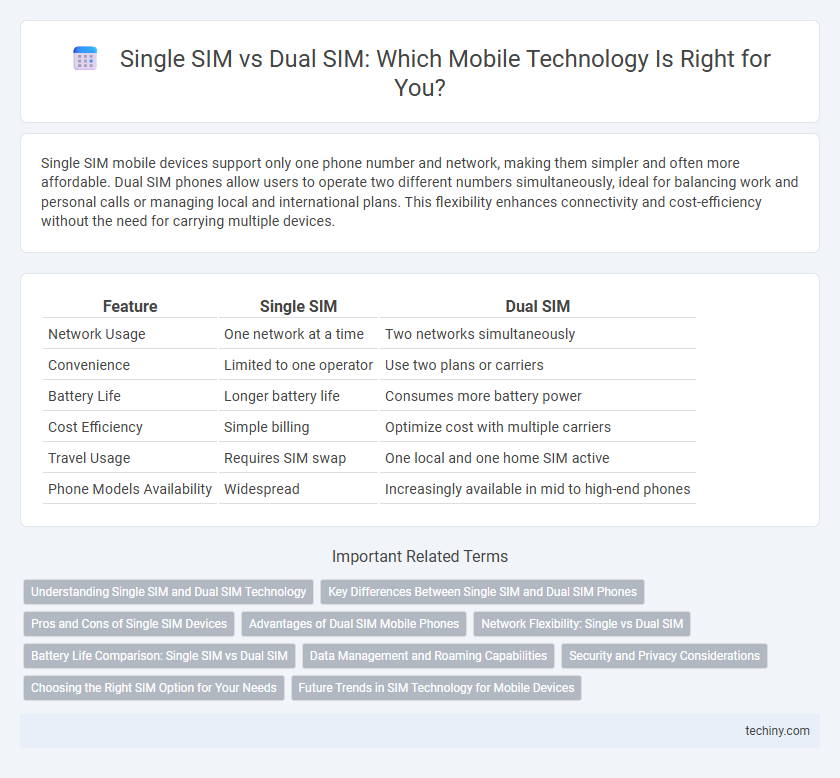Single SIM mobile devices support only one phone number and network, making them simpler and often more affordable. Dual SIM phones allow users to operate two different numbers simultaneously, ideal for balancing work and personal calls or managing local and international plans. This flexibility enhances connectivity and cost-efficiency without the need for carrying multiple devices.
Table of Comparison
| Feature | Single SIM | Dual SIM |
|---|---|---|
| Network Usage | One network at a time | Two networks simultaneously |
| Convenience | Limited to one operator | Use two plans or carriers |
| Battery Life | Longer battery life | Consumes more battery power |
| Cost Efficiency | Simple billing | Optimize cost with multiple carriers |
| Travel Usage | Requires SIM swap | One local and one home SIM active |
| Phone Models Availability | Widespread | Increasingly available in mid to high-end phones |
Understanding Single SIM and Dual SIM Technology
Single SIM technology allows a mobile device to operate with one SIM card, providing a single phone number and network connection ideal for straightforward usage. Dual SIM technology enables the use of two SIM cards simultaneously, offering flexibility to manage personal and business numbers or to switch between different carriers for better coverage and cost efficiency. This dual SIM capability is particularly beneficial in regions with varying network strengths or for travelers seeking to avoid roaming charges.
Key Differences Between Single SIM and Dual SIM Phones
Single SIM phones support only one mobile network, while dual SIM phones enable the use of two SIM cards simultaneously, allowing users to manage two numbers on one device. Dual SIM models provide advantages such as separating work and personal calls, using multiple carriers for better coverage, and reducing roaming costs by switching SIMs as needed. Single SIM phones typically offer simpler setups and slightly better battery life, making them suitable for users who do not require multiple network connections.
Pros and Cons of Single SIM Devices
Single SIM devices offer simplicity in management, reducing the risk of network conflicts and saving battery life compared to dual SIM phones. They typically provide more internal storage and better overall performance due to dedicated resources for one active SIM. However, single SIM phones limit users to one network provider, which can reduce flexibility in coverage and data plan options.
Advantages of Dual SIM Mobile Phones
Dual SIM mobile phones offer enhanced convenience by allowing users to manage two phone numbers on a single device, ideal for separating work and personal communications. They provide cost-efficiency by enabling users to switch between carriers for better coverage or cheaper data plans, especially beneficial in regions with varying network strengths. Dual SIM functionality also supports travel flexibility, allowing seamless use of local SIM cards without removing the primary SIM, reducing roaming charges and maintaining constant connectivity.
Network Flexibility: Single vs Dual SIM
Dual SIM smartphones offer enhanced network flexibility by allowing users to operate two different carriers simultaneously, enabling seamless switching between networks based on signal strength and data plans. Single SIM devices rely solely on one carrier, potentially limiting coverage options and increasing dependency on a single network's availability. Dual SIM technology benefits frequent travelers and professionals by providing continuous connectivity and cost-effective management of voice and data services across multiple networks.
Battery Life Comparison: Single SIM vs Dual SIM
Dual SIM smartphones typically consume more battery power than Single SIM devices due to constant network monitoring and signal switching between two SIM cards. Single SIM phones benefit from reduced background processes and lower radio frequency usage, resulting in longer battery life under similar conditions. Real-world tests show Dual SIM usage can decrease battery longevity by 10-20%, depending on network strength and usage patterns.
Data Management and Roaming Capabilities
Dual SIM smartphones enable efficient data management by allowing users to allocate data usage between two separate networks, optimizing cost and connectivity. They enhance roaming capabilities by providing the flexibility to maintain a local SIM for data and a home SIM for voice calls, reducing international roaming charges. Single SIM devices, while simpler, limit users to one carrier's data plan and roaming options, potentially increasing costs during travel.
Security and Privacy Considerations
Single SIM devices offer enhanced security by limiting exposure to multiple network vulnerabilities and reducing the risk of SIM swapping attacks. Dual SIM phones, while providing flexibility, can complicate privacy management due to simultaneous network connections that may increase data leakage risks. Choosing between Single SIM and Dual SIM requires evaluating the trade-offs between connectivity convenience and the potential for increased attack surfaces in mobile security.
Choosing the Right SIM Option for Your Needs
Selecting between single SIM and dual SIM mobile phones depends on individual usage patterns and connectivity requirements. Dual SIM devices offer the advantage of managing two phone numbers simultaneously, ideal for separating work and personal communications or leveraging multiple carrier plans for better coverage and cost savings. Single SIM phones provide simplicity, potentially enhanced battery life, and compatibility with all mobile networks, making them suitable for users with straightforward mobile needs.
Future Trends in SIM Technology for Mobile Devices
Emerging trends in SIM technology emphasize eSIM and integrated SIM solutions, enabling seamless switching between multiple carriers without physical SIM cards. Dual SIM capabilities are evolving with eSIM adoption, offering enhanced flexibility and improved network connectivity for mobile devices. Future developments will likely prioritize remote SIM provisioning and secure, cloud-based management to optimize user experience and device interoperability.
Single SIM vs Dual SIM Infographic

 techiny.com
techiny.com